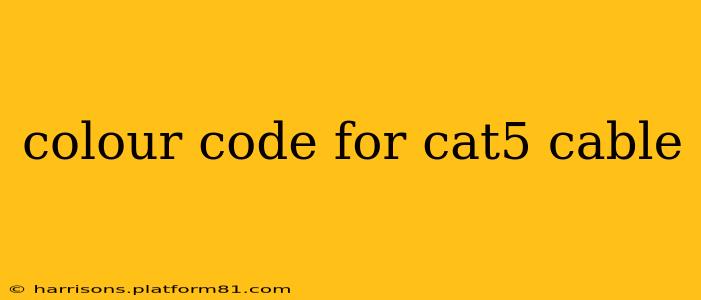The Color Code for Cat5 Cable: A Comprehensive Guide
Understanding the color code of Cat5 cabling is crucial for anyone working with networking infrastructure. While seemingly simple, the precise arrangement of wires within the cable dictates its functionality and ensures proper data transmission. This guide will delve into the specifics of Cat5 cable color codes, addressing common questions and misconceptions.
What is Cat5 Cable and Why Does the Color Code Matter?
Cat5 cable, short for Category 5 cable, is a twisted-pair cable used for Ethernet networking. The twisting of the wire pairs helps reduce electromagnetic interference (EMI) and crosstalk, ensuring signal integrity and reliable data transfer. The color code is essential because it dictates how the wires are connected at each end, ensuring proper signal pairing. Incorrect wiring will lead to network connectivity issues or complete failure.
The Standard T568A and T568B Wiring Standards
There are two main wiring standards for Cat5 cable: T568A and T568B. While both are functionally equivalent, they use different color arrangements. Consistency is key; you must use the same standard at both ends of the cable. Mixing standards will result in a non-functional cable.
T568A:
- Pair 1 (Green): Solid Green, Green/White
- Pair 2 (Orange): Solid Orange, Orange/White
- Pair 3 (Brown): Solid Brown, Brown/White
- Pair 4 (Blue): Solid Blue, Blue/White
T568B:
- Pair 1 (Orange): Solid Orange, Orange/White
- Pair 2 (Green): Solid Green, Green/White
- Pair 3 (Blue): Solid Blue, Blue/White
- Pair 4 (Brown): Solid Brown, Brown/White
Notice how the orange and green pairs swap places between the two standards.
What is the difference between T568A and T568B?
There's no functional difference between T568A and T568B. The choice between them is largely arbitrary. Consistency is the only critical factor. Many large organizations standardize on one or the other for easier maintenance and troubleshooting.
How to identify the correct wiring scheme?
Carefully inspect the cable's ends. Most pre-made cables will be clearly labeled with either T568A or T568B. If you're making your own cables, refer to a wiring diagram or use a cable tester to verify the wiring scheme.
What happens if I mix T568A and T568B wiring?
Mixing T568A and T568B wiring at each end of the cable will result in a faulty connection. Data transmission will fail, and you won't have network connectivity.
Can I use a different color code scheme?
No, deviating from the standard T568A or T568B color codes is strongly discouraged. It will cause incompatibility with standard network equipment and make troubleshooting extremely difficult. Stick to the established standards for reliable networking.
What about Cat5e and Cat6 cables?
The color coding for Cat5e and Cat6 cables remains consistent with the T568A and T568B standards outlined above. While the internal construction and performance specifications differ, the color code for identifying the wire pairs stays the same.
This comprehensive guide should clarify the color coding for Cat5 cables and its importance in networking. Remember, consistency in wiring standards is crucial for reliable data transmission. If you're unsure about any aspect of wiring your network cables, it's always best to consult a qualified technician.
